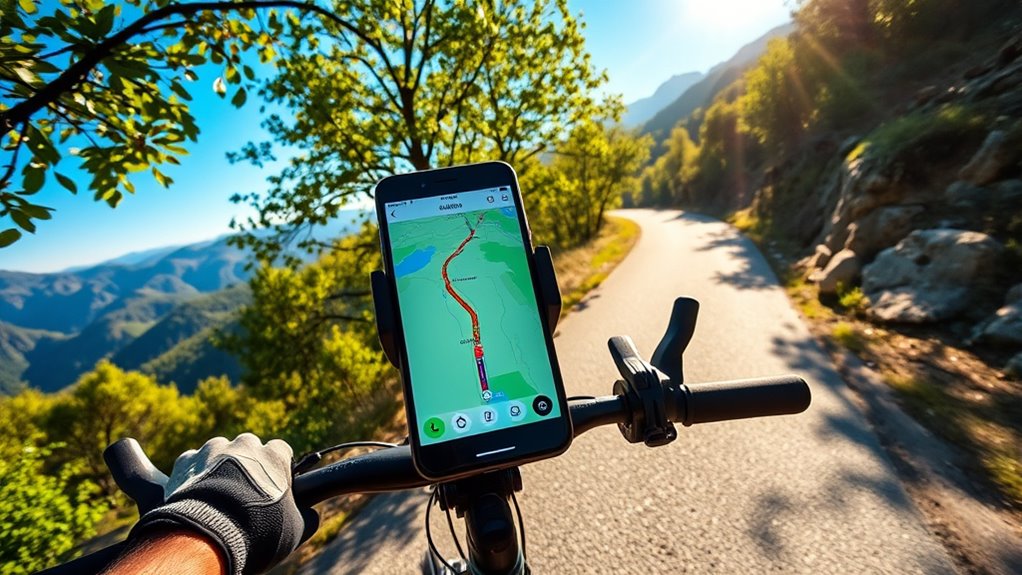To use GPS for cycling navigation, first select a durable, weather-resistant device or app with long battery life. Plan your route carefully by checking terrain, elevation, and bike-friendly paths, and customize your settings before you start. During your ride, input your destination, choose the right mode, and keep an eye on turn alerts and directions. Regularly maintain your device and stay aware of environmental conditions, ensuring a safe and enjoyable journey—if you want to improve your skills, there’s more to explore.
Key Takeaways
- Select a durable, waterproof GPS device or app with customizable settings and enable power-saving modes before riding.
- Plan your route using terrain analysis, scenic options, and alternative paths; update maps regularly for accuracy.
- Input your destination and preferred route type, then customize display and safety alerts for clear, real-time navigation.
- Mount your device securely on your bike, keep firmware and maps updated, and carry portable chargers for extended rides.
- Use turn alerts and visual cues, stay aware of surroundings, and be prepared to switch to manual navigation if needed.
Choosing the Right GPS Device or App
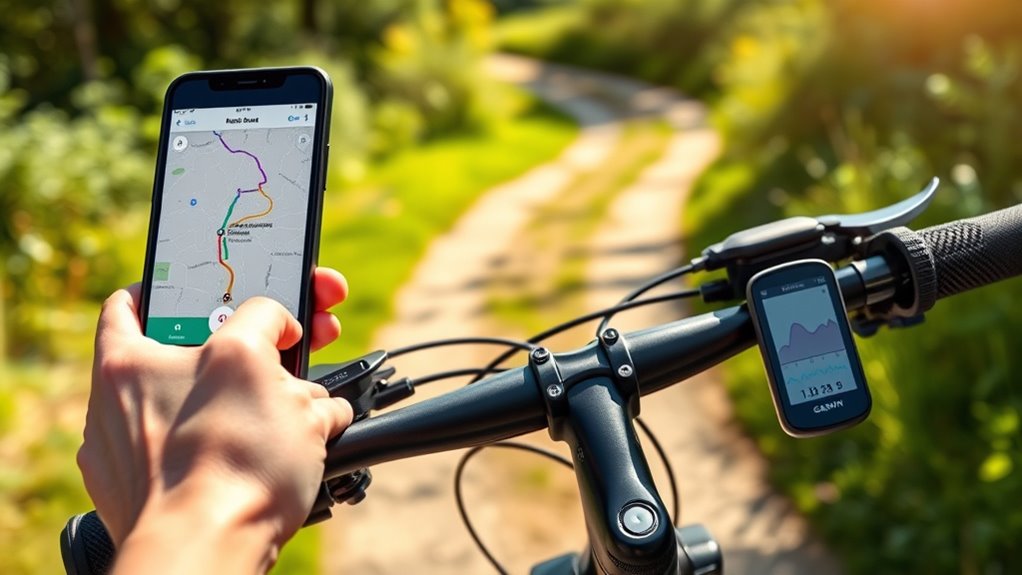
When selecting a GPS device or app for cycling, it’s vital to take into account your specific needs and riding style. Battery life is a key factor—you want a device that lasts through long rides without needing frequent recharges. Look for options with extended battery durations, especially if you enjoy multi-hour adventures. Additionally, some devices leverage AI-powered data analytics to optimize route suggestions and improve performance during your rides. Device durability also matters; cycling can be tough on gadgets, so choose a device that’s rugged and weather-resistant to withstand rain, bumps, and rough terrain. Consider how well the device is built and whether it offers protective features like reinforced casings or waterproof ratings. Balancing battery life and durability ensures your GPS will perform reliably, providing accurate navigation and peace of mind during every ride. Incorporating professional services such as expert consultation or repairs can further enhance your experience. environmental considerations, such as low light pollution areas or scenic routes, can enhance your outdoor experience while ensuring your device performs well in various conditions. Remember that data privacy features are also important if you prefer to keep your riding routes and personal information secure.
Planning Your Route Effectively
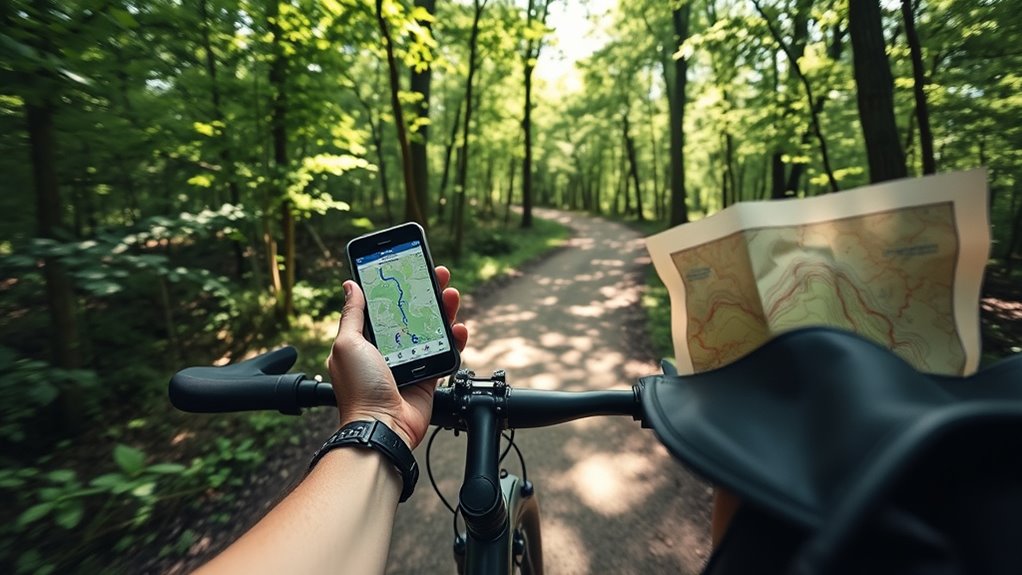
Planning your route effectively is essential to guarantee a safe and enjoyable cycling experience. Proper route planning helps you avoid hazards and ensures you stay on suitable terrain. Start with terrain analysis by identifying areas with steep inclines, busy roads, or rough surfaces. Use your GPS to explore alternative paths and scenic routes that match your skill level. Consider factors like distance, elevation, and traffic to optimize your ride. Here are some tips to enhance your route planning: – Check elevation profiles to avoid strenuous climbs – Identify bike-friendly roads and dedicated cycling lanes – Use terrain analysis tools to spot hazards – Plan rest stops and water sources along the route. Incorporating visual cues or other innovative features can also inspire creative ways to prepare your cycling space or gear, enhancing your overall experience. Ensuring your bicycle’s drivetrain is well-maintained and properly shifting can prevent delays and keep you on track during your ride. Additionally, understanding the benefits of hydration can help you stay energized and safe during longer rides. This approach guarantees a smoother, safer ride tailored to your preferences.
Setting Up Your GPS for Cycling
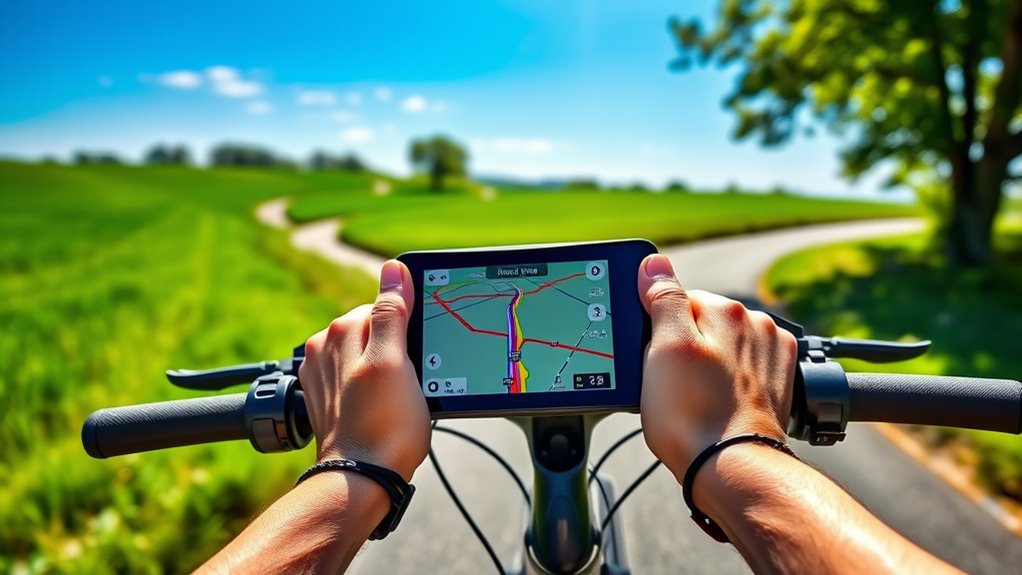
To get started, you need to select the cycling mode on your GPS device to optimize it for your ride. Next, input your destination details accurately so you won’t get lost along the way. Finally, customize your navigation settings to suit your preferences for a smoother cycling experience. Additionally, consider exploring essential oil benefits to enhance your overall well-being during your ride. Incorporating calming sound therapy can also improve focus and relaxation while cycling. Understanding how vehicle tuning can optimize your bike’s performance might inspire you to fine-tune your equipment for better efficiency.
Select Cycling Mode
Choosing the right cycling mode on your GPS is vital for accurate tracking and navigation. Different modes enhance your device for various cycling activities, guaranteeing better performance and data precision. When selecting a mode, consider your cycling gear and weather conditions, as these influence your needs. For example, mountain biking modes adjust for rough terrain, while road cycling modes focus on speed and distance. Deaf Vibes can provide insights into how auditory cues can support navigational awareness in noisy environments. Additionally, some GPS devices include AI-driven features that adapt to your riding patterns, improving route suggestions and safety. Understanding the different cycling modes available on your device can help you choose the most suitable setting for your ride. For optimal results, match the mode to your bike type and cycling environment. Adjust settings for weather considerations, like rain or extreme heat. Enable features like elevation tracking if you’re tackling hilly routes. Confirm your cycling gear is compatible with the selected mode for ideal performance. Additionally, understanding your personality traits can help tailor your cycling experience, such as choosing routes that match your confidence level or social preferences. Being aware of your fitness level can also guide you in selecting appropriate cycling modes to prevent overexertion and ensure a safe ride.
Input Destination Details
Once you’ve set the appropriate cycling mode on your GPS, the next step is inputting your destination details. Start with destination entry by selecting the search or address input feature on your device. Type in the address, landmark, or point of interest you want to reach. Confirm the location on the map, making sure it’s accurate.
After selecting your destination, proceed with route input by choosing the preferred route options if available, such as shortest, fastest, or bike-friendly. Your GPS will then generate the route, displaying turns and directions.
Make sure to double-check the destination details for accuracy before starting your ride. Proper destination entry and route input ensure your navigation is precise and tailored to your cycling journey.
Customize Navigation Settings
Before you start your ride, it’s vital to customize your navigation settings to guarantee a smooth cycling experience. First, adjust the display to show relevant information like upcoming turns, distance, and elevation. You can also customize the display style for better visibility in different lighting conditions. To ensure safety and comfort, consider setting up safety features such as audible alerts and automatic rerouting options. Next, set your preferred route preferences, such as avoiding highways or tolls. Be sure to adjust audio alerts so you receive timely voice prompts without distraction. Additionally, configure map orientation—north-up or track-up—for better navigation clarity. Also, selecting the appropriate business services may help in planning your stops or accommodations along the route. Familiarize yourself with navigation features to maximize your device’s capabilities during the ride. Being aware of city-specific considerations can also improve your experience in urban areas. Consulting local retail hours can help you plan stops at nearby stores if needed. Finally, check your device’s brightness and contrast settings to ensure visibility in various weather conditions. Customizing display and adjusting audio help tailor your GPS experience, making navigation more intuitive and less stressful during your ride.
Using GPS Features During Your Ride
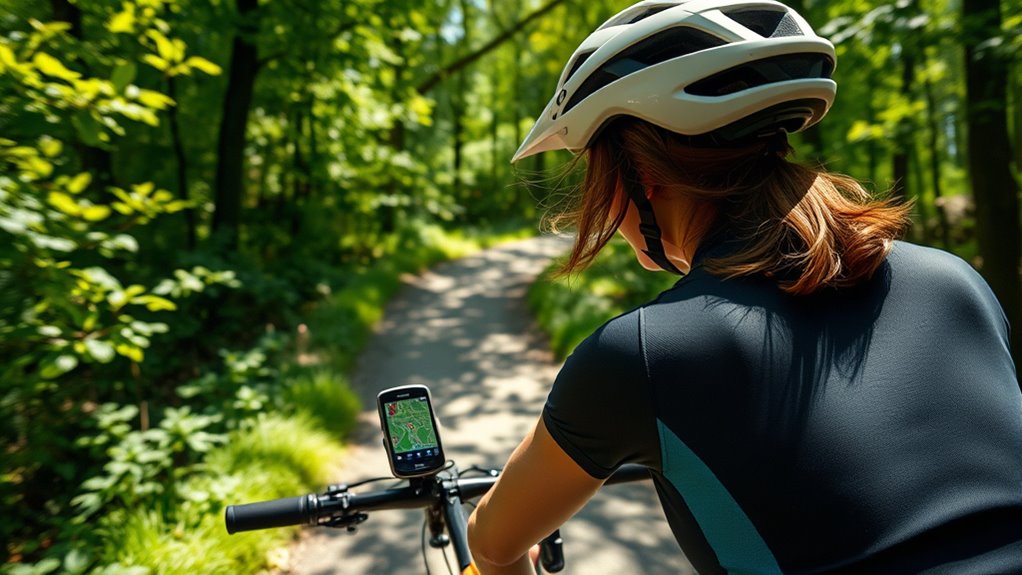
Once you’re on your ride, make sure your device is set up correctly to access its features smoothly. Use maps to stay on course and explore new routes confidently. Don’t forget to enable turn alerts so you get notified of upcoming turns without breaking your focus. Incorporating navigation tools ensures you can efficiently manage your route and make real-time adjustments as needed.
Setting Up Your Device
To make the most of your GPS device during your ride, start by customizing your settings before you hit the road. Verify your device’s battery life is optimized by dimming the screen or turning off unnecessary features.
Check that it has a waterproof design or is properly protected, especially if you encounter rain. Adjust the screen brightness for visibility in different lighting conditions.
Set up your preferred units and ensure tracking accuracy with the right satellite system. Consider enabling power-saving modes to extend battery life.
These steps help your device perform reliably, so you can focus on the ride without interruptions or concerns about water damage. Proper setup ensures smooth navigation and a safer cycling experience.
Navigating With Maps
After setting up your device, using GPS maps during your ride allows you to navigate efficiently and confidently. Make sure your cycling gear includes a mount that keeps your device accessible and visible.
As you follow your route, pay attention to weather considerations; rain or strong sunlight can affect screen visibility. Use the zoom feature to see upcoming turns clearly, especially in tricky terrain.
Keep your device updated with the latest maps for accuracy. Don’t rely solely on audio cues—occasionally glance at the screen to confirm your position.
If weather changes suddenly, adjust your route if necessary to stay safe. Properly configured GPS maps ensure smooth navigation, helping you focus on enjoying your ride without getting lost.
Using Turn Alerts
Turn alerts are a valuable feature that helps you stay on course without constantly glancing at your device. They notify you in advance of upcoming turns, keeping your ride smooth and safe.
To make the most of this feature, explore turn alert customization options to set alerts that suit your preferences. Adjust audible notification settings so you hear alerts clearly without being overwhelmed. You can typically choose between sound, vibration, or both.
Some GPS apps allow you to customize the distance for alerts, giving you flexibility depending on your riding pace. Additionally, verify your device volume and vibration are properly configured.
Using these features effectively helps you focus on your ride while staying confidently on route.
Staying Safe and Navigating in Real-Time
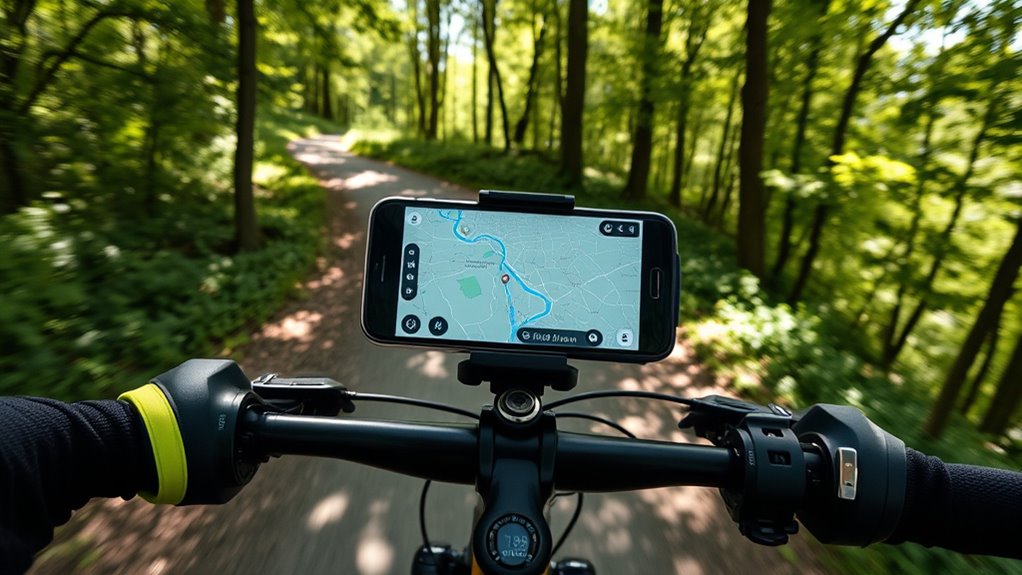
Using GPS while cycling allows you to stay safe and navigate effectively in real-time, but it’s crucial to pay close attention to your surroundings.
Using GPS helps navigation but staying aware of your surroundings ensures safety on every ride.
Weather considerations can change quickly, so check forecasts before heading out and adjust your route or gear accordingly. Rain, wind, or fog can reduce visibility and make navigation more challenging, so stay alert and use your device’s alerts to stay on course.
Emergency preparedness is essential; carry a fully charged phone, a small first aid kit, and know basic safety protocols.
Keep your GPS device visible without distracting from your ride, and be ready to manually navigate if needed.
Staying aware of your environment ensures a safer, more confident cycling experience, especially in unpredictable conditions.
Tips for Maintaining Your GPS and Improving Accuracy
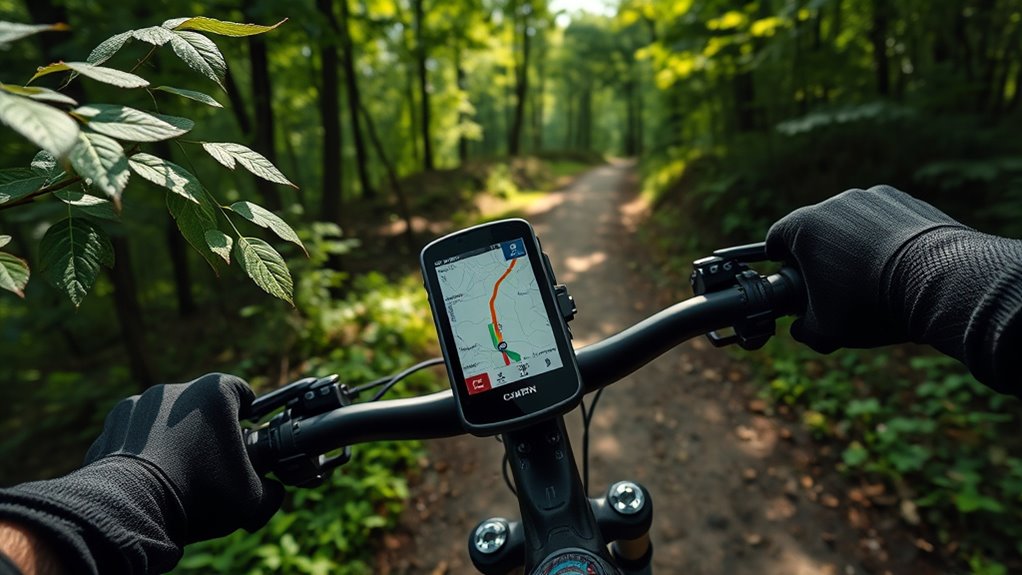
Maintaining your GPS device is key to guaranteeing accurate navigation during your ride. Proper battery maintenance prevents unexpected shutdowns, so keep it charged and carry a portable charger if possible.
Regular firmware updates fix bugs, enhance features, and improve accuracy, so check for updates frequently.
Keep your device clean and free from dirt or debris that could affect signals. Additionally, calibrate your GPS regularly to ensure precise positioning.
- Charge your device fully before rides and avoid extreme temperatures.
- Update firmware to access improvements and new maps.
- Clean the device and its sensors after each ride.
- Calibrate your GPS for peak accuracy in different environments.
Frequently Asked Questions
Can GPS Devices Be Used Offline Without Internet Connection?
Yes, you can use GPS devices offline without an internet connection. You just need to download offline maps beforehand and activate GPS caching, which stores map data locally on your device.
This way, you’re not reliant on real-time data or Wi-Fi. Make sure your device has enough storage for offline maps, and plan ahead to ensure your maps are current, so you can navigate smoothly during your ride.
How Does Weather Affect GPS Signal Accuracy During Cycling?
Weather can impact your GPS signal accuracy during cycling by causing satellite communication issues and signal interference. Heavy rain, thunderstorms, or dense clouds may weaken the signals your device receives from satellites, leading to less precise navigation.
Wind and atmospheric conditions also play a role, potentially disrupting signal transmission. To minimize these effects, make certain your GPS device has a clear view of the sky and avoid riding through severe weather whenever possible.
Are There Specific GPS Settings for Mountain Biking or Trail Riding?
For mountain biking or trail riding, you should customize your GPS with mountain biking settings or trail riding configurations. These settings optimize your device for rough terrain, increased accuracy, and quick route recalculations.
Enable off-road modes, adjust map detail levels, and turn on trail-specific features like elevation tracking. Doing so helps you navigate challenging trails confidently, ensuring your GPS provides reliable guidance tailored to your adventurous ride.
How Can I Conserve Battery Life on My GPS Device During Long Rides?
Imagine stretching your adventure just a bit longer—you’re in control. To conserve battery life, activate power saving mode on your GPS device, which dims the screen and reduces unnecessary functions.
Carry a portable battery backup to keep the device energized during extended rides. Adjust screen brightness, turn off unused sensors, and limit auto-lock features.
These simple steps help you maintain your navigation, ensuring your journey continues smoothly without worrying about losing power.
What Are Common Troubleshooting Steps for GPS Signal Loss?
When facing GPS signal loss, first check for potential GPS signal interference from tall buildings, dense foliage, or electronic devices nearby.
Confirm your device firmware is up-to-date, as updates often fix bugs and improve signal stability.
If issues persist, restart your device, reset the GPS module, or move to an open area with a clear sky.
These troubleshooting steps help restore reliable GPS signals during your ride.
Conclusion
By mastering your GPS, you’ll become an unstoppable cycling legend, conquering every trail and city street with ease. No more wrong turns or getting lost in the wilderness—your device will be like a personal navigator guiding you through the toughest terrain and busiest streets alike. With these tips, you’ll turn your bike rides into epic adventures, feeling like you have a superpower. Get ready to ride smarter, safer, and more confidently than ever before!
